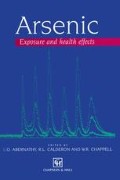Abstract
Inner Mongolia is an autonomous region of China south of the Gobi desert and north and west of the great wall of China (Figure 5.1). Its capital was established as Huhhot in 1954. The Huhhot region lies in a triangular, segmented and sunken lake basin in Inner Mongolia, China, south of the Daqing (Great Green) Mountains and along the northern coast of the Yellow River (Figure 5.2). This region comprises approximately 4800km2. The subterranean waters occur in a Q4 earth stratum and have a naturally occurring high concentration of arsenic from the local rock. High levels of arsenic (mainly As+3) and of fluoride are found in the water, as are low levels of dissolved oxygen, sulfate, nitrate, and selenium, and traces of iron and manganese. The aquifers provide a reducing environment, rich in organic substances, in which arsenic easily moves and accumulates. The western Huhhot basin is an agricultural area, raising wheat, millet, corn, green beets, potatoes and sunflowers. Arsenical pesticides have not been used. No factories, mines or other industries discharge arsenic into the local air, water or soil. Examination of the surface soils, air, fish and crops have not found arsenic levels above the Chinese standards. The smoking habits in Huhhot resemble those of the general Chinese culture.
Access this chapter
Tax calculation will be finalised at checkout
Purchases are for personal use only
Preview
Unable to display preview. Download preview PDF.
References
Byrd, D.M., Roegner, M.L., Griffiths, J.C. et al. (1996) Carcinogenic risks of inorganic arsenic in perspective. Int. Arch. Occup. Environ. Health, 68, 484–94.
Fan Chengwan, Naren Gaowa, Zhang Yumin et al. (1993) Analysis for arsenical water and approach for reason of rich arsenic in Western Huhhot Basin. Environment and Health, 10(2), 56–8.
Luo Zhendong, Zhang Yumin, Ma Liang et al. (1993) Epidemiological survey of chronic arsenic poisoning at Tie Mengeng and Zhi Jiliang villages in Inner Mongolia. Chinese Public Health, 9(8), 347–8.
Zhang Yumin, Ma Liang, Luo Zhengdong et al. (1994) Water quality analysis of arsenic-enriched groundwater in the large area of Western Huhhot Basin. Rural Eco-Environment, 10(1), 59–61.
Editor information
Editors and Affiliations
Rights and permissions
Copyright information
© 1997 Springer Science+Business Media Dordrecht
About this chapter
Cite this chapter
Luo, Z.D. et al. (1997). Chronic arsenicism and cancer in Inner Mongolia — consequences of well-water arsenic levels greater than 50 μg/l. In: Abernathy, C.O., Calderon, R.L., Chappell, W.R. (eds) Arsenic. Springer, Dordrecht. https://doi.org/10.1007/978-94-011-5864-0_5
Download citation
DOI: https://doi.org/10.1007/978-94-011-5864-0_5
Publisher Name: Springer, Dordrecht
Print ISBN: 978-94-010-6478-1
Online ISBN: 978-94-011-5864-0
eBook Packages: Springer Book Archive

